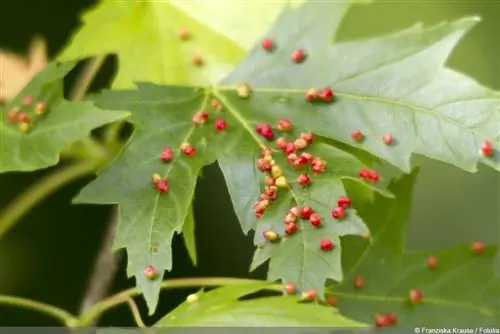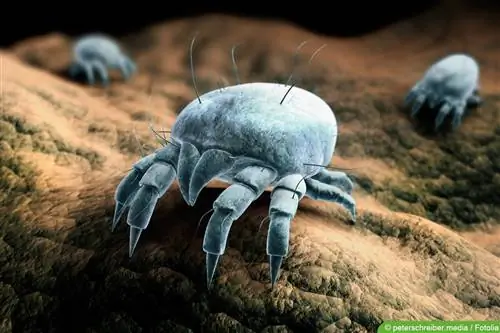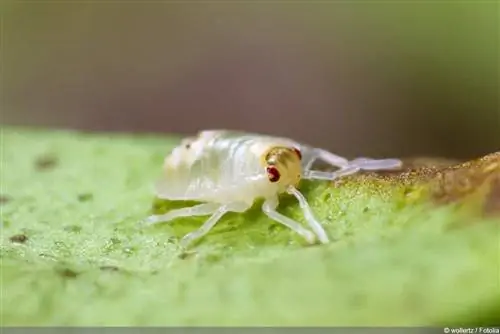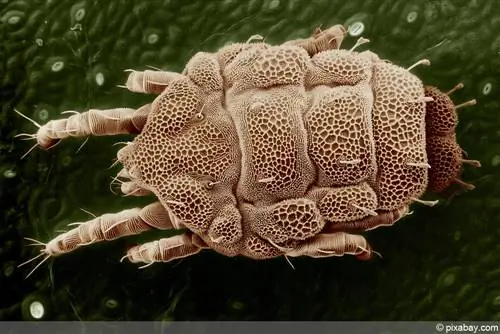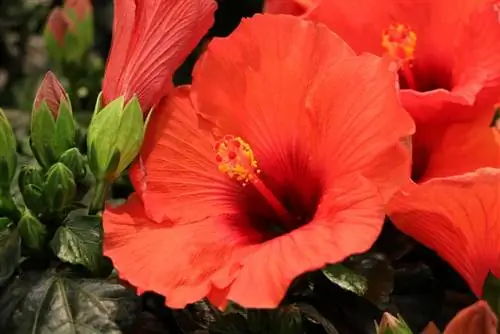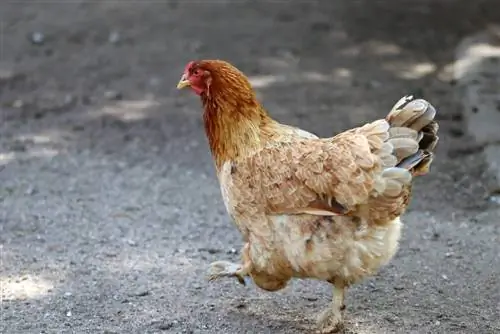- Author admin [email protected].
- Public 2023-12-24 17:10.
- Last modified 2025-01-24 12:45.
When gall mites spread to plants, the first signs of damage usually become visible quickly. It's easy to resort to the chemical club to get a quick fix. But for the sake of the environment alone, natural sprays against gall mites should be used. The plant guide explains what works effectively and describes in detail how you can easily produce them yourself.
Recognize
In order to carry out a targeted fight against gall mites, the infestation must be identified precisely in advance. The microscopic Eriophyidae with a size between 0.2 and 0.5 millimeters cannot be seen with the naked eye. For this reason, you can only identify an infestation by the damage caused to the affected plants. If your plant shows the following symptoms, it is most likely one of the countless gall mite species:
- Round or pointed growths on the leaves and/or branches
- Hairy or felt-like leaf and stem/branch coverings
- Deformed fruit heads
- Lack of fruiting
- Disturbances in ripening of already existing fruits
- Hollow buds that stay closed
- Flowers do not form until the end
- Leaves and needles change color and fall off
- Particularly affected plants
Gall mites are usually only attracted to certain plants that are considered particularly at risk. These include, among others:
- Maple trees
- Berry bushes
- Mugwort
- Birches
- Book
- Alders
- Ash trees
- Dogwood
- Linden
- Needle firs
- Nut trees
- Plum and plum trees
- Roses
- elms
- Rowberries
- Ziest (Stachys)
Best time to fight
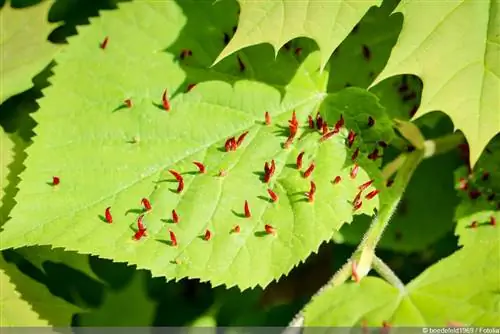
Gall mites spend the winter on and predominantly in their preferred plants. For this reason, effective control is no longer possible from mid-autumn onwards because they then settle in their winter quarters and can no longer be reached. You should therefore always spray between spring and late summer or at the latest in early autumn to early October. They are active in the warm months and there is a good chance of finding them on the outside of plants. If, for example, you assume a gall mite infestation in November due to the typical damage, immediate control will not be of any use and you should wait until next spring.
Natural sprays
In order to protect the environment, protect ecologically valuable insects in the area and also not to expose yourself and your neighbors to chemical pollutants from pesticides, you can easily make natural sprays yourself on a purely biological basis to combat gall mites. There are various options available to you.
Stinging nettle manure
Required materials
- Larger bucket or barrel with lid/cover
- Fresh nettles
- Spray pump with larger nozzle
- Garden hose
- Garden scissors
- Gloves against skin contact with nettles
- If necessary, wear a face mask to prevent the smell
- A stick, branch or similar for stirring
Manufacturing
- Cut fresh nettles so small that they fit easily into the bucket/barrel
- Fill the bucket/barrel 3/4 full with the nettles (approximately one kilogram of nettles per ten liters of water)
- Fill bucket/barrel completely with water
- Seal as airtight as possible
- Stir the mixture daily
- Fermentation time: between two and three weeks
Tip:
As a strong and, for many, unpleasant odor develops, it is advisable to position the bucket/barrel in a place where the odor will not be disturbing.
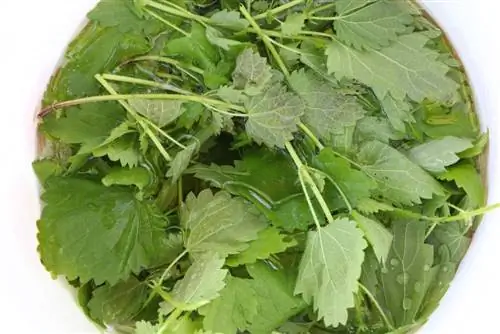
Application
Once the nettle mass has fermented, it is poured into a pointed pump and used as follows:
- Application on a cloudy day is optimal to avoid burns to the plant
- Spray the plant dripping wet with the nettle manure
- Repeat the process every two to three days for a period of one week to ten days (depending on the extent of the infestation)
Stinging nettle broth
Fighting with nettle broth works more slowly than nettle manure. This is produced in a similar way to manure. Only the longer fermentation time is eliminated. Here, after about two days of preparation, you can sieve the nettle residue out of the water and then use the brew as a spray. Appeals should be made daily for at least a week.
ivy weed
Slightly gentler than with nettle liquid, but more effective than a nettle decoction, you can use ivy liquid to combat gall mites. The advantage is that there is no longer a long fermentation time and this manure is ready for use much more quickly.
Required materials
- Bucket or barrel with the most airtight seal possible
- One kilogram of ivy for ten liters of water
- Stirring rod
- Spray pump with large nozzle
Manufacturing
- Cut the ivy into small pieces, put it in a bucket/barrel and pour water over it
- Mix the mixture well so that there are no air spaces
- Bucket/barrel shoot well
- Open the bucket/barrel after three days - the manure is ready for use when bubbles have formed
- Can be used and kept for a few weeks
Application
- Always stir the young manure well before use
- Mix with water in a ratio of 1:20 and only then pour into the spray pump
- Spray infected plants while they are dripping wet
- Repeat three to four times every two days
- Make sure that you do not hit any insects, as the ivy is poisonous to them
Wormwood infusion
Materials needed
- Fresh or dried wormwood (Artemisia absinthium)
- A cooking pot
- Water
- Spray pump
sieve
Manufacturing
- Fill the pot with the wormwood herb
- Add enough water so that it is at least three to five centimeters above the herb
- Cook for about 45 minutes
- Stir occasionally
- Then strain the herb out of the brew and let it cool to room temperature
- Brew is stored in an airtight container and will last for at least a week
Application
- Pour the cooled wormwood stock into a spraying device
- Spray the affected plant while it is dripping wet
- Repeat the spraying process once a day for the next three days
- Do not use in direct sunlight as it may cause burns to the plant
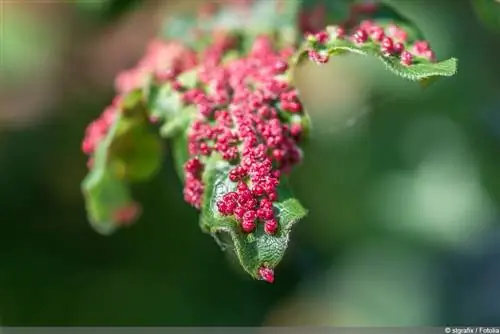
tansy tea
Material required:
- 200 to 300 grams of tansy
- Pot
- Boiling water
- Something to stir
- Spray pump
sieve
Manufacturing
- Bring the water to a boil
- Put the tansy in a pot and pour the boiling water over it
- The water level should be high enough to just cover the tansy
- Let it steep for between ten and 20 minutes
- Sifting tansy from the brew
- Finally, set the brew to room temperature to cool down
Application
- Mix with stale, low-lime water in a ratio of maximum 1:1
- Fill the brew into the spray pump
- Spray the affected plant generously and dripping wet
- Best time to spray early in the morning before the sun gets too hot
Neem oil
Neem oil is a biological product that, when used against gall mites, clogs the respiratory tract and causes the parasites to suffocate. To do this, the neem oil must reach the animals directly and the application must be carried out accurately and extensively. Neem oil is ideal as a natural spray for smaller plants where you can easily trim all parts of the plant and especially below the leaves. It is not advisable to use it on conifers. The gall mites hollow out the needles and often sit in them. The neem oil wouldn't reach them.
Neem oil is available in ready-to-use spray bottles, so there is no need to prepare it. Lavita, for example, has a neem oil spray that works directly against mites.
Combination with other control measures
If you have a severe gall mite infestation, you can achieve better and faster control efficiency if you combine a natural spray with another control measure. This could, for example, be the use of natural predators that feed on gall mites. You can get these in any well-stocked garden supply store for little money.
The gall mite's predators include:
- Predatory mites
- Ladybug
- Predator bugs
NOTE:
Manure and neem oil as sprays should not be used if predators are used at the same time, as they would also die.

